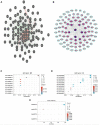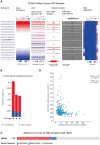Overexpressed CMTM6 Improves Prognosis and Associated With Immune Infiltrates of Ovarian Cancer
- PMID: 35174213
- PMCID: PMC8841687
- DOI: 10.3389/fmolb.2022.769032
Overexpressed CMTM6 Improves Prognosis and Associated With Immune Infiltrates of Ovarian Cancer
Abstract
Ovarian cancer (OV) is an epithelial malignancy that intrigues people for its high mortality and lack of efficient treatment. Chemokine-like factor (CKLF)-like MARVEL transmembrane domain containing 6 (CMTM6) can be observed in various cancers, but its part in OV remains little known. Hence, the prognostic value and underlying mechanism of CMTM6 in OV were preliminarily evaluated. Here, we determined that CMTM6 expression was higher than that in normal controls. However, the upregulation of CMTM6 was associated with better prognosis. GSEA results suggested that CMTM6 is involved in the immune-related and metabolism-related pathways. GO/KEGG analysis of CMTM6 coexpressed genes was performed to survey the possible regulatory roles of CMTM6 in OV. Subsequently, CMTM6 expression was positively correlated with the infiltration levels of immune cells and the expression of diverse immune cell marker sets. Importantly, CMTM6 may influence prognosis partially by regulating immune infiltration in OV. Last, copy number variations (CNVs) and DNA methylation might prompt the abnormal CMTM6 expression in OV. In conclusion, CMTM6 can serve as a novel prognostic biomarker in patients with OV.
Keywords: CMTM6; biomarker; immunity; ovarian cancer; prognosis.
Copyright © 2022 Yin, Ding, Hu, Yang, Huang, Dong, Li and Han.
Conflict of interest statement
The authors declare that the research was conducted in the absence of any commercial or financial relationships that could be construed as a potential conflict of interest.
Figures









References
-
- Azimi F., Scolyer R. A., Rumcheva P., Moncrieff M., Murali R., McCarthy S. W., et al. (2012). Tumor-infiltrating Lymphocyte Grade Is an Independent Predictor of sentinel Lymph Node Status and Survival in Patients with Cutaneous Melanoma. Jco 30 (21), 2678–2683. 10.1200/JCO.2011.37.8539 - DOI - PubMed
-
- Block M. S., Dietz A. B., Gustafson M. P., Kalli K. R., Erskine C. L., Youssef B., et al. (2020). Th17-inducing Autologous Dendritic Cell Vaccination Promotes Antigen-specific Cellular and Humoral Immunity in Ovarian Cancer Patients. Nat. Commun. 11 (1), 5173. 10.1038/s41467-020-18962-z - DOI - PMC - PubMed
LinkOut - more resources
Full Text Sources

